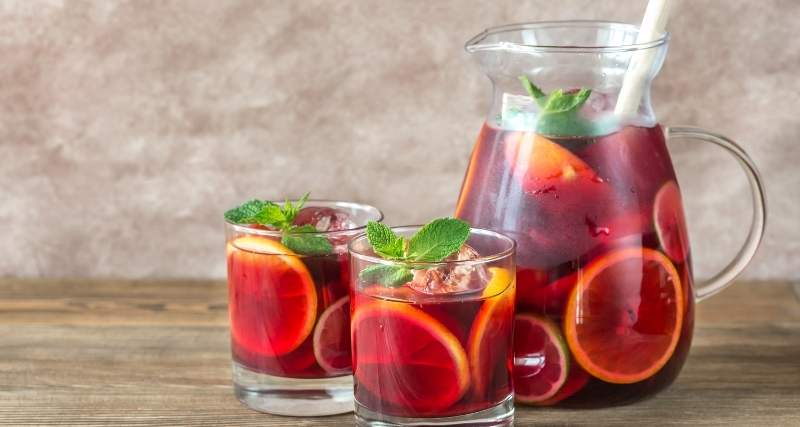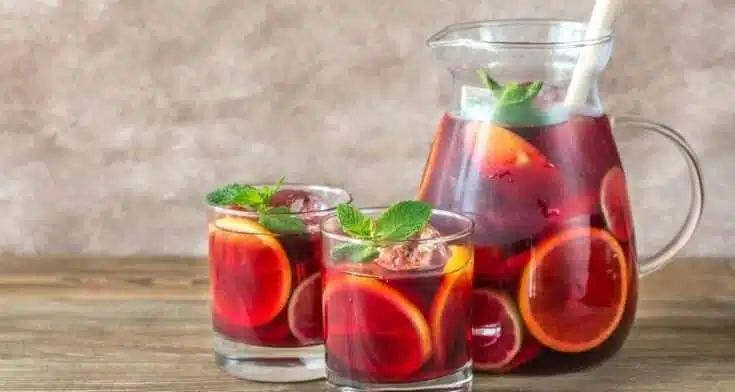Learn how to prepare a traditional Spanish Sangria recipe. This Spanish summer drink is popular all over the world and is very easy to make at home.
One unique thing about Spanish cultures is that they’ve perfected their art on drinks that suit various seasons. The beverages range from Sangria, Tinto de Verano, Cava, Agua de Valencia, Rebujito, and other Spanish drinks.
Sangria is an unconventional classic, used as an aperitif or digestif that gets guests talking at parties. The drink that defines Spain is one of its national symbols, and a must-try when visiting the country!
Have a barbecue? Just add a fun pitcher of sangria. Dinner party coming up? Try out this sangria recipe to get things started. Better yet, mix and match the ingredients below to make your own signature drink!
Read also: The 10 Most Popular Spanish Drinks & Cocktails
What is Sangria?
Sangria is a drink of alcoholic mixture—the wine used in making sangria determines its color. White wine makes white sangria, while red wine makes red sangria.
It is a cocktail widely popular in Spain, Italy, Portugal, and South America. This wine-based drink is made with fresh fruit, brandy, or whiskey.
Originally from the Andalusian region, Sangria has many regional variations. And depending on the area of Spain where you’re making your Sangria, you may also add spices such as cinnamon and cloves to your beverage.
Sangria is a must-have at summer parties!
Creating an authentic sangria recipe doesn’t have a single way to prepare it, but it is still essential to know how to use its ingredients.
Therefore, the traditional sangria recipe can contain:
- Sparkling water
- Fruit Juice
- Sweeteners
- Fruits
- Liquor (flavored)
Where is Sangria from?

Sangria drink is from Spain. Every menu in Spain probably has an authentic sangria recipe. This classic drink is served to many people all over the Mediterranean. But, Spain is the only place that considers sangria as tradition.
Recently, the European Parliament approved the term “sangria” as an aromatized product of wine due to its origin.
Sangria is a name generated from “Sangre,” a Spanish word. In Latin, it is known as “sanguis.” It refers to blood or dark color.
There are various versions of sangria that come from Spaniards. Most of the food historians believe that it reached America during the early 1800s.
The Spanish use the term as a cliché because it has become an attractive product for millions of people visiting the country. When people seek the sand, sun, and a drink, sangria offers them solace during the parties.
The history of this classic drink began over two thousand years back. It started with the Romans who have crossed the Iberian Peninsula. They were farmers, and during their journey, the Romans planted vineyards.
People couldn’t drink water during this period; hence they commonly came with another fortified way. Therefore, they began using alcohol to treat bacteria issues that affected the people.
The Romans made the first sangria drink which included a heavy mixture of spices, rich wine, herbs, and water.
They added various things to destroy any bacteria found in the water. It was also a way of disguising the terrible tastes of wine served to them while they feasted.
Sangria Ingredients
The Spanish sangria recipe offers a classic pitcher drink that can be mixed easily. It’s a versatile drink that comes in many versions hence taste differently according to one’s preference.
As earlier mentioned, you can customize sangria with either white or red wine. And add to your favorite drink some tasty fruits.
Best Red Wine for Sangria
A fruity, young red wine is best for making sangria. Since Spain is the world’s third-largest producer of red wine, Spaniards would certainly recommend that you choose one of their excellent wines for your sangria.
A popular choice is Rioja wine, which typically consists of Garnacha or varieties of Spanish tempranillo grapes.
Don’t spend too much on an expensive bottle. The perfect way to dress up leftover or inexpensive wine is to turn it into sangria.
Avoid using in the authentic Spanish recipe anything aged. You wouldn’t want anyone getting a hangover.
Brandy
Among Spanish sangria recipes, this is the spirit most commonly used. Alternatively, if you don’t have any, feel free to substitute cognac or orange liqueur. They all work just perfectly!.
Tons Of Fruits!
As you have already guessed, Sangria is very sweet, with a distinctive fruity flavor!
And where does that come from? Tons of chopped-up fruit of course!
Three common fruits you’ll find in Spain are oranges, lemons, and green apples. However, I do encourage you to also add any other juicy fruit you may have on hand and make it your own.
Have fun with it!
Sweeten It Up
To make sangria sweeter, add as much sweetener as you want!
The Spanish have a standard sugar or brown sugar syrup that is made by melting equal parts boiling water and sugar. But you can use maple syrup or honey instead for a natural alternative, or any sweet juice that will boost up your flavor!
Make It Fizzy!
Fizzing up your sangria is totally up to you! Although many people prefer it to be flat, you can top off your glasses with a light soda like Sprite, La Casera, ginger ale, or simple sparkling water before serving it.
Sangria Recipe Variations:
Sangria is one of the best summertime drinks for those hot, sweltering days when you don’t feel like yourself without a fruity adult beverage of some kind.
I love its bright color, fresh fruit flavors, and the variety of options you have when it comes to choosing your base spirit, fruit type, and liquid accompaniment.
Sangria comes together with a little mixology, a dash of wine, and all sorts of add-ins. However, the beauty of sangria is that it really is more of a method than an exact recipe.
And if you are anything like me, you should know that the best sangrias are made from whatever fruit happens to be sitting there on your counter and begging to be taken out for a drink.
So just gather whatever ingredients you have on hand and customize a batch to your liking. For example, feel free to swap out the fruits for different flavors, or use pomegranate juice for a fruity punch.
There are really no rules to a great sangria recipe! Sweeten or punch up the flavor and make it your own!
Switch up the Wine
With Spanish sangria, it is traditional to use red wine. However, you could also pair your cocktail mixture with a good white wine or rosé wine from Spain!
For example, if you prefer white wine over red, swap the red wine with a dry sparkling wine like Prosecco or Cava. Or maybe you prefer something a little different? Feel free to experiment!
Experiment With Liqueur
Sangria can also be made with cognac, orange liqueur, Cointreau, or Triple Sec if brandy isn’t your thing.
Make your sangria as strong or as light as you’d like by adding your liquor of choice
Add Fruit of Choice
Fresh or frozen fruit can be used to make sangria, so feel free to toss in whatever you have on hand. Add in some golden delicious apples for sweetness, some dark red berries for richness, or peel and squeeze some orange slices for bright citrus notes.
Citrus fruit, berries, grapes, pineapple, mango, and kiwi are among some of the favorites.
Spice It Up
For an extra kick, muddle some fresh ginger with your sangria. And of course, how could you forget cinnamon!
The cinnamon stick is almost always present in a pitcher of sangria here, and I like how it adds a gentle hint of warmth.
Lastly, another way to spice up your drink is to add a jalapeno slice or two to give it a subtle but intriguing kick!
Sangria is one of those drinks that’s hard to screw up and is endlessly customizable.No matter what type of Sangria you like, it’s a guaranteed crowd-pleaser!
Traditional Spanish Sangria Recipe – Step-by-step instructions
Check out our traditional sangria recipe to prepare this popular Spanish summer drink at home.
By following these simple steps, you can create the perfect sangria recipe to satisfy everyone at your barbeque or
picnic!
1. Optional: If you want to use sugar to make a sweeter sangria, dissolve two tablespoons of brown sugar in two tablespoons of water over low heat to create a syrup. Afterward, let it cool.
2. Juice 1.5 oranges so that you have around 3/4 cup of fresh orange juice.
3. Chop the remaining half orange and half an apple into small pieces.
4. Stir together one bottle of dry red wine, the fresh orange juice, optional syrup, brandy or vermouth (optional), and the orange and apple pieces.
5. Add ice cubes (and optional a carbonated beverage) just before serving.
6. Enjoy your homemade sangria!
Traditional Spanish Sangria Recipe – Step-by-step instructions
Traditional Spanish Sangria Recipe

Ingredients
- 750 ml bottle dry Spanish red wine
- 1/2 apple
- 2 oranges
- 3/4 cup (fresh) orange juice
- 1/3 cup brandy or vermouth
- Optional: 2 tablespoons brown sugar
- Optional: Carbonated beverage like lemon soda or soda water
- Ice cubes
Instructions
- Optional: If you want to use sugar to make a sweeter sangria, dissolve two tablespoons of brown sugar in two tablespoons of water over low heat to create a syrup. Afterward, let it cool.
- Juice 1.5 oranges so that you have around 3/4 cup of fresh orange juice.
- Chop the remaining half orange and half an apple into small pieces.
- Stir together one bottle of dry red wine, the fresh orange juice, optional syrup, brandy or vermouth (optional), and the orange and apple pieces.
- Add ice cubes (and optional a carbonated beverage) just before serving.
- Enjoy your homemade sangria!
Nutrition Information:
Yield:
4Serving Size:
1Amount Per Serving: Calories: 339Total Fat: 0gSaturated Fat: 0gTrans Fat: 0gUnsaturated Fat: 0gCholesterol: 0mgSodium: 49mgCarbohydrates: 41gFiber: 3gSugar: 31gProtein: 1g
The nutritional information provided is approximate and can vary depending on several factors, so is not guaranteed to be accurate.
